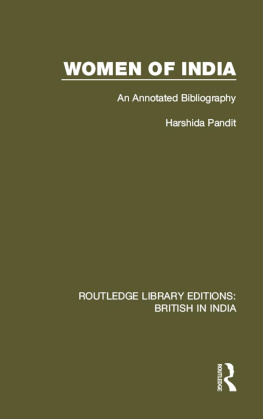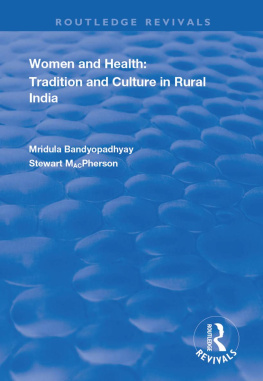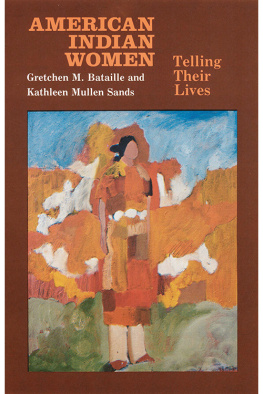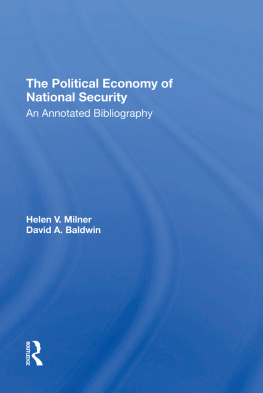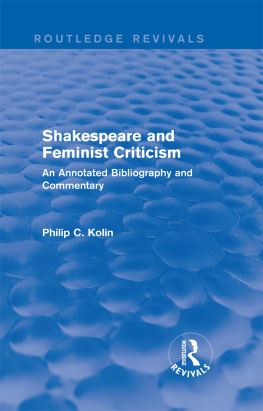ROUTLEDGE LIBRARY EDITIONS: BRITISH IN INDIA
Volume 26
WOMEN OF INDIA
WOMEN OF INDIA
An Annotated Bibliography
HARSHIDA PANDIT
First published in 1985 by Garland Publishing Inc.
This edition first published in 2017
by Routledge
2 Park Square, Milton Park, Abingdon, Oxon OX14 4RN
and by Routledge
711 Third Avenue, New York, NY 10017
Routledge is an imprint of the Taylor & Francis Group, an informa business
1985 Harshida Pandit
All rights reserved. No part of this book may be reprinted or reproduced or utilised in any form or by any electronic, mechanical, or other means, now known or hereafter invented, including photocopying and recording, or in any information storage or retrieval system, without permission in writing from the publishers.
Trademark notice: Product or corporate names may be trademarks or registered trademarks, and are used only for identification and explanation without intent to infringe.
British Library Cataloguing in Publication Data
A catalogue record for this book is available from the British Library
ISBN: 978-1-138-22929-7 (Set)
ISBN: 978-1-315-20179-5 (Set) (ebk)
ISBN: 978-1-138-29229-1 (Volume 26) (pbk)
ISBN: 978-1-315-23306-2 (Volume 26) (ebk)
Publishers Note
The publisher has gone to great lengths to ensure the quality of this reprint but points out that some imperfections in the original copies may be apparent.
Disclaimer
The publisher has made every effort to trace copyright holders and would welcome correspondence from those they have been unable to trace.
WOMEN OF INDIA
An Annotated Bibliography
Harshida Pandit
1985 Harshida Pandit
All rights reserved
Library of Congress Cataloging in Publication Data
Pandit, Harshida, 1927
Women of India.
(Garland reference library of social science ; vol. 152)
Includes index.
1. WomenIndiaBibliography. 2. WomenIndiaSocial conditionsBibliography. I. Title. II. Series: Garland reference library of social science ; v. 152.
Z7964.I5P36 1985 016.3054 82-49172
[HQ1742]
ISBN 0-8240-9175-2 (alk. paper)
Printed on acid-free, 250-year-life paper
Manufactured in the United States of America
ACKNOWLEDGMENTS
This bibliography would not have been conceived without Dr. Esther Steinmans inspiration and insistence. I had to visit different libraries in Bombay to look at various publications for annotation. I must confess that not only the librarian friends at Shrimati Nathibai Damodar Thackersey University Library, but also librarians at the American Library, British Council Library, Institute of Social Sciences, Tata Institute of Social Sciences, Bhavans library, Maniben Nanavati College Library were most generous and helpful. I am thankful for all the help they rendered.
My special thanks to Miss Hilda Sales-Pontes, Miss Leena Pandya, Miss Jayshree Patel, Mrs. Rani Ghosh, Miss Tara Sheth, and Miss Minal Gandhi for helping me in listing, annotating, classification and also for guiding me in getting specific library assistance. I want to express my heartfelt thanks to them.
My thanks are due to Mr. K. Venkatraman for going through the draft manuscript and rendering editorial assistance and to Miss Carmel Dias for typing the manuscript so accurately. Lastly, I must express my grateful thanks to my husband Mr. Ramu Pandit, who always encouraged and guided me in my moments of disappointments and diffidence in completing this stupendous task.
My former student and close friend Ms. Ila Doshit who is now settled in the United States also showered me with new ideas, suggestions, and literature with great enthusiasm. I shall ever remain thankful to her for her generous assistance.
The completion of this project took much longer than I had envisaged. I am grateful to Ms. Marie Ellen Larcada of Garland Publishing, Inc., for understanding my difficulties and encouraging me to complete the assignment.
I will appreciate it very much if the users send me their reactions, suggestions, and criticisms.
Harshida Pandit
Department of Psychology
S.N.D.T. Womens University
Bombay 400 020
India
CONTENTS
The status and position of Indian women have undergone many changes since the high status they enjoyed in the Vedic era yielded to forced suicide during the dark ages, female infanticide, purdah, child marriages, the prohibition of widows remarriages, the denial of property rights, or the right to inheritance and the denial of freedom to participate in political movements both during the past and pre-Independence days.
The advent of the 19th century ushered in a new era in the liberation of women. This was possible due to the relentless struggle fought by women on the socio-political and legal fronts. The social reform movements turned public opinion against the earlier practices of Sati, child marriages, infanticide of female children, and enforced widowhood. Progressive legislation as well as the social reform movements led by Iswarchandra Vidyasagar and Raja Rammohan Roy and later by the All-India Womens Conference and Mahatma Gandhi helped ease the restraining yoke. The progressive steps taken by the Indian government since Independence by way of granting certain rights and principles and doing away with some evil practices have brought about definite changes. The passing of the Hindu Code Bill in 1956, though welcome, cannot be deemed sufficient in itself to lead to the acceptance of women as equals in every walk of life. Much remains to be done to accomplish this objective.
Women in Indias Population
Since 1901, when census taking began in India, the female-male population ratio has consistently declined: in 1901, it was 972 women per 1,000 males; in 1911, it was 964; 955 in 1921; 950 in 1931; 945 in 1941; 946 in 1951; 941 in 1961; 930 in 1971; and 935 in 1981. These declining figures could be explained in various ways: perhaps more boys are born than girls; the survival rate for female infants may be lower than for males; or the decline may be due to the recent trend towards aborting females. Whatever the reason, the fact remains that the population ratio is unfavorable to females, as are the life expectancy figures: 47.1 years for Indian males and 45.6 years for females.
Similarly, the figures for literacy are also disheartening. Indian women are lagging behind, for lack of opportunities. In 1901 the literacy rate among women was 0.8%; by 1981, it had increased to only 24.8%. Enrollment of women in institutions of higher learning is not as high as it should be.
Legal Rights
The legal rights of women in India under the Civil Laws are extensive. The Hindu Code Bill (1956), the Special Marriage Act (1954), the Hindu Marriage Act (1955), and the Hindu Succession and Adoption and Maintenance Acts (1956) do fulfill the need of doing away with the injustices suffered by the women of India. But translating these rights into reality is another matter, and women do not benefit as much as they should. For example, polygamy still exists, despite the law forbidding it; moreover, in recent years it has acquired the form of Friendship Contracts, very similar to a mans keeping a concubine or a mistress. Even when valid grounds for divorce exist, uneducated and economically dependent wives often cannot take recourse to law as legal proceedings against their husbands may lead them to face social ostracism since public opinion still favors men.

